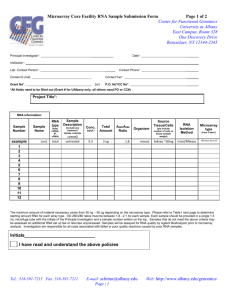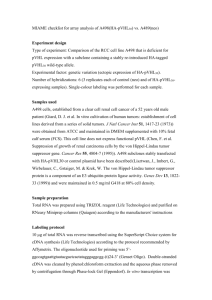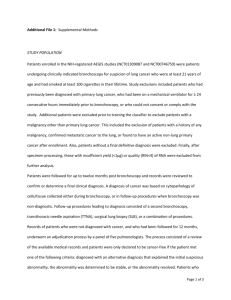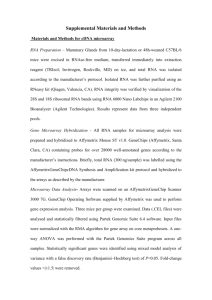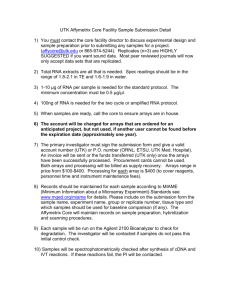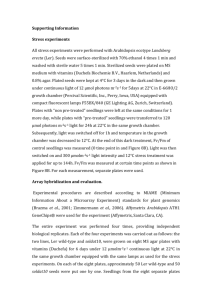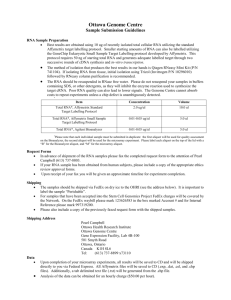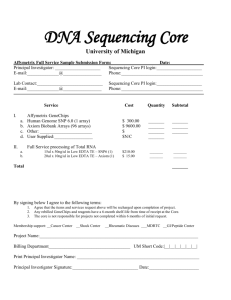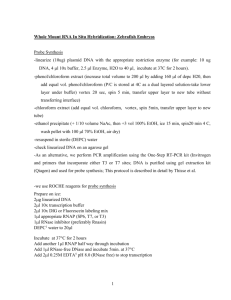Supplementary Methods - Word file
advertisement
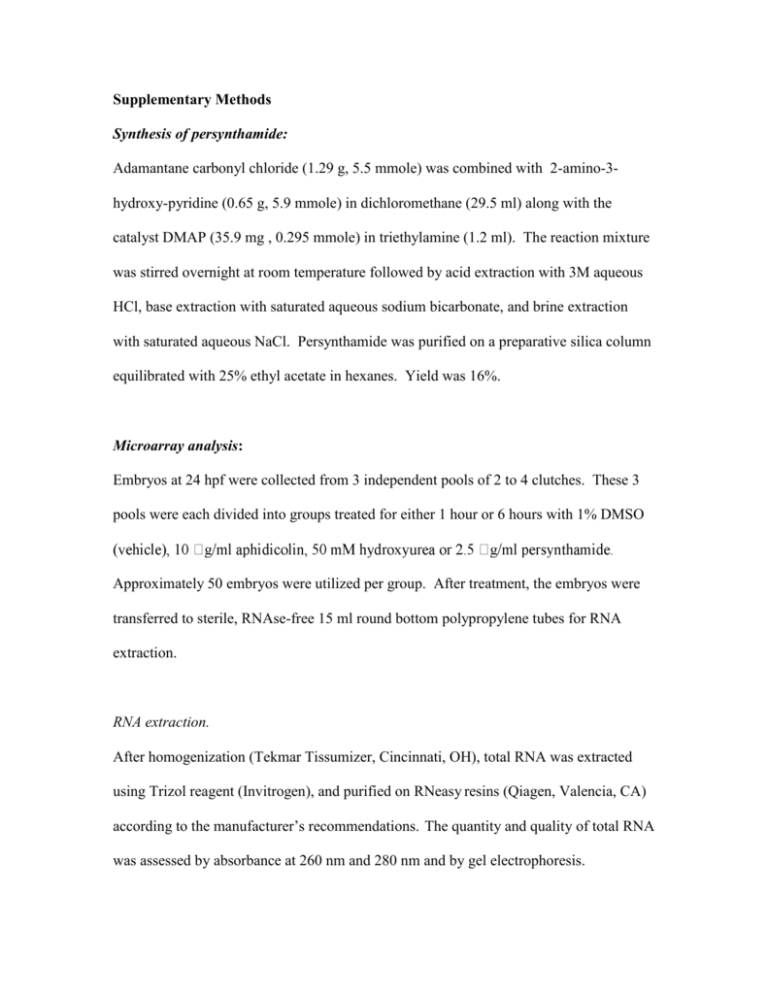
Supplementary Methods Synthesis of persynthamide: Adamantane carbonyl chloride (1.29 g, 5.5 mmole) was combined with 2-amino-3hydroxy-pyridine (0.65 g, 5.9 mmole) in dichloromethane (29.5 ml) along with the catalyst DMAP (35.9 mg , 0.295 mmole) in triethylamine (1.2 ml). The reaction mixture was stirred overnight at room temperature followed by acid extraction with 3M aqueous HCl, base extraction with saturated aqueous sodium bicarbonate, and brine extraction with saturated aqueous NaCl. Persynthamide was purified on a preparative silica column equilibrated with 25% ethyl acetate in hexanes. Yield was 16%. Microarray analysis: Embryos at 24 hpf were collected from 3 independent pools of 2 to 4 clutches. These 3 pools were each divided into groups treated for either 1 hour or 6 hours with 1% DMSO Approximately 50 embryos were utilized per group. After treatment, the embryos were transferred to sterile, RNAse-free 15 ml round bottom polypropylene tubes for RNA extraction. RNA extraction. After homogenization (Tekmar Tissumizer, Cincinnati, OH), total RNA was extracted using Trizol reagent (Invitrogen), and purified on RNeasy resins (Qiagen, Valencia, CA) according to the manufacturer’s recommendations. The quantity and quality of total RNA was assessed by absorbance at 260 nm and 280 nm and by gel electrophoresis. Target preparation, hybridization, and signal detection. with an oligo(dT) primer that included a T7 RNA polymerase promoter site at the 5’ end. cDNA was then used directly in an in vitro transcription reaction in the presence of biotinylated nucleotides (BioArray High Yield RNA Transcript Labeling Kit, Enzo, Farmingdale, NY) to produce biotinwas subsequently fragmented (Ambion, Austin, TX) and hybridized to Affymetrix zebrafish GeneChips1,2, according to the manufacturer’s guidelines (Affymetrix, Santa Clara, CA). After staining with a streptavidin-phycoerythrin conjugate (Molecular Probes, Eugene, OR), the fluorescence of bound RNA was quantitated using a GeneChip scanner (Affymetrix). Method for identifying differentially expressed genes, based on a control spike-in dataset. We chose to apply a set of Affymetrix analysis methods that optimize the detection of differentially expressed genes, according to a recently developed control spike-in dataset3. Most of these methods are implemented in Bioconductor’s “affy” package4,5, supplemented with custom scripts available6. Briefly, the procedure involves generating 8 expression summary datasets, using the MAS background correction method7,8, 4 different normalization algorithms (loess, invariant set, quantile and constant), the MAS 5.0 estimate of non-specific signal7, and 2 different robust estimators (Tukey-Biweight and median polish). The 8 expression summary datasets are then combined, to generate a summary significance statistic that includes an intensity-dependent error model, derived from CyberT9,10. Permutation testing results in false discovery rate estimates corresponding to various significance statistic levels. For details, refer to6. In general, genes with a q-value < 0.04 and absolute fold change > 1.25 were called significantly regulated. An additional filter was applied to eliminate genes called absent under all conditions using the MAS 5.0 absent-present call7. Agglomerative (hierarchical) cluster analysis was performed, using centroid linkage and an uncentered Pearson correlation coefficient as the distance metric11. Ambiguities in the ordering of nodes were resolved by using the results of a self-organizing map (SOM, employing an uncentered correlation coefficient). Clustergrams were visualized using publicly available software12. BrdU incorporation and analysis: Zebrafish embryos were dechorionated and chilled on ice for 15 minutes and transferred to a 10mM BrdU, 15% DMSO solution and incubated on ice for 20 minutes. Embryos were then transferred to warm embryo media and incubated for 5 minutes at 28.5C. For wholemount immunostaining, embryos were fixed in 4% paraformaldehyde for 2 hours room temperature and transferred to methanol for overnight at -20C. They were then rehydrated to PBST, digested with proteinase K (10g/ml) and post-fixed in 4% paraformaldehyde for 20 minutes at room temperature. Embryos were then washed in H20 and incubated in 2N HCl for 1 hour at room temperature. Embryos were washed well in PBST and placed in block (PBST with 0.2% blocking reagent [Roche], 10% lamb serum and 1% DMSO) for 30 minutes room temperature. Embryos were incubated in monoclonal anti-BrdU antibody (1:100 dilution) (Sigma) for at least 2 hours room temperature and then washed in PBST. They were then incubated in goat anti-mouse horseradish peroxidase-conjugated antibody (Jackson Immunoresearch) for 2 hours RT, washed in PBST and then developed in diaminobenzidine/H2O2 (Sigma). For flow cytometry analysis, pools of embryos were disaggregated as described for DNA content analysis after BrdU incorporation. Cells were then passed through a 40micron mesh and fixed in 70% ethanol. Cells were stained with FITC-conjugated mouse monoclonal anti-BrdU antibody according to manufacturer specifications (BD were analyzed with a FACScaliber machine (BD Biosciences). Quantitative RT-PCR: RNA was extracted using Trizol reagent (Invitrogen). cDNA was made with the Advantage for RT-PCR kit (BD Biosciences). Quantitative RT-PCR was done for cyclin B1 with the following primer pair (forward primer: 5’-ACAGCCCAAGAAGGATTCTC3’ reverse primer: 5’-TCTGCGTCAACATCCTTGAT-3’). ß-actin was used as a reference gene (forward primer: 5’-GCTGTTTTCCCCTCCATTGTT-3’ reverse primer: 5’-TCCCATGCCAACCATCACT-3’). The iCycler iQ real-time PCR detection system was used with SYBR green according to the manufacturer’s protocol (Biorad). Data was analyzed using the comparative Ct method. Supplementary References 1. Affymetrix GeneChip Arrays: Zebrafish Genome Array. http://www.affymetrix.com/products/arrays/specific/zebrafish.affx 2. Lockhart D.J., et al. Expression monitoring by hybridization to high-density oligonucleotide arrays. Nat Biotechnol 14,1675-80 (1996). 3. Choe S.E., Boutros, M., Michelson, A.M., Church, G.M. & Halfon, M.S. Preferred analysis methods for Affymetrix GeneChips revealed by a wholly-defined control dataset. submitted (2004). 4. The R Project for Statistical Computing. http://www.r-project.org/ 5. Bioconductor: open source software for bioinformatics. http://www.bioconductor.org. 6. The Golden Spike Experiment. http://genetics.med.harvard.edu/~schoe/spike 7. Affymetrix: Statistical Algorithms Description Document. http://www.affymetrix.com/support/technical/whitepapers/sadd_whitepaper.pdf. 8. Affymetrix Support: Microarray Suite Software. http://www.affymetrix.com/support/technical/byproduct.affx?product=mas 9. Baldi P. & Long A.D. A Bayesian framework for the analysis of microarray expression data: regularized t -test and statistical inferences of gene changes. Bioinformatics 17, 509-19 (2001). 10. Institute for Genomics and Bioinformatics, University of California, Irvine: Welcome to Cyber-T. http://visitor.ics.uci.edu/genex/cybert/ 11. de Hoon M.J., Imoto S., Nolan J. & Miyano S. Open source clustering software. Bioinformatics 20, 1453-54 (2004). 12. Saldanha A. & Segal A. Java Treeview 5.0. http://sourceforge.net/projects/jtreeview/
